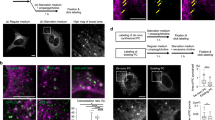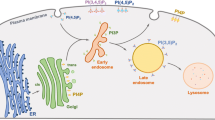Abstract
The GL15 glioblastoma cell line undergoes viability loss upon treatment with bromopyruvate. The biochemical mechanisms triggered by the antiglycolytic agent indicate the activation of an autophagic pathway. Acridine orange stains acidic intracellular vesicles already 60 min after bromopyruvate treatment, whereas autophagosomes engulfing electron dense material are well evidenced 18 h later. The autophagic process is accompanied by the expression of the early autophagosomal marker Atg5 and by LC3-II formation, a late biochemical marker associated with autophagosomes. In agreement with the autophagic route activation, the inhibitory and the activator Akt and ERK signaling pathways are depressed and enhanced, respectively. In spite of the energetic collapse suffered by bromopyruvate-treated cells, MALDI-TOF mass spectrometry lipid analysis does not evidence a decrease of the major phospholipids, in accordance with the need of phospholipids for autophagosomal membranes biogenesis. Contrarily, mitochondrial cardiolipin decreases, accompanied by monolyso-cardiolipin formation and complete cytochrome c degradation, events that could target mitochondria to autophagy. However, in our experimental conditions cytochrome c degradation seems to be independent of the autophagic process.
Similar content being viewed by others
References
Aoki H, Takada Y, Kondo S, Sawaya R, Aggarwal BB, Kondo Y (2007) Evidence that curcumin suppresses the growth of malignant gliomas in vitro and in vivo through induction of autophagy: role of Akt and extracellular signal-regulated kinase signaling pathways. Mol Pharmacol 72:29–39
Bartlett GR (1959) Phosphorus assay in column chromatography. J Biol Chem 234:466–468
Bligh EG, Dyer WJ (1959) A rapid method of total lipid extraction and purification. Can J Biochem Physiol 37:911–917
Botti J, Djavaheri-Mergny M, Pilatte Y, Codogno P (2006) Autophagy signaling and the cogwheels of cancer. Autophagy 2:67–73
Buratta M, Castigli E, Sciaccaluga M, Pellegrino RM, Spinozzi F, Roberti R, Corazzi L (2008) Loss of cardiolipin in palmitate-treated GL15 glioblastoma cells favors cytochrome c release from mitochondria leading to apoptosis. J Neurochem 105:1019–1031
Bustamante E, Morris HP, Pedersen PL (1981) Energy metabolism of tumor cells. Requirement for a form of hexokinase with a propensity for mitochondrial binding. J Biol Chem 256:8699–8704
Cairns RA, Harris IS, Mak TW (2011) Regulation of cancer cell metabolism. Nat Rev Cancer 11:85–95
Castigli E, Arcuri C, Giovagnoli L, Luciani R, Giovagnoli L, Secca T, Gianfranceschi GL, Bocchini V (2000) Interleukin-1β induces apoptosis in GL15 glioblastoma-derived human cell line. Am J Physiol Cell Physiol 279:C2043–C2049
Castigli E, Sciaccaluga M, Schiavoni G, Brozzi F, Fabiani R, Gorello P, Gianfranceschi GL (2006) GL15 and U251 glioblastoma-derived human cell lines are peculiarly susceptible to induction of mitotic death by very low concentrations of okadaic acid. Oncol Rep 15:463–470
Chen Y, McMillan-Ward E, Kong J, Israels SJ, Gibson SB (2007) Mitochondrial electron-transport-chain inhibitors of complexes I and II induce autophagic cell death mediated by reactive oxygen species. J Cell Sci 120:4155–4166
Eom JM, Seo MJ, Baek JY, Chu H, Han SH, Min TS, Cho CS, Yun CH (2010) Alpha-eleostearic acid induces autophagy-dependent cell death through targeting AKT/mTOR and ERK1/2 signal together with the generation of reactive oxygen species. Biochem Biophys Res Commun 391:903–908
Girardi JP, Pereira L, Bakovic M (2011) De novo synthesis of phospholipids is coupled with autophagosome formation. Medical Hypotheses 77:1083–1087
Hailey DW, Kim PK, Satpute-Krishnan P, Rambold AS, Mitra K, Sougrat R, Lippincott-Schwartz J (2010) Mitochondria supply membranes for autophagosome biogenesis during starvation. Cell 141:656–667
Jelluma N, Yang X, Stokoe D, Evan GI, Dansen TB, Haas-Kogan DA (2006) Glucose withdrawal induces oxidative stress followed by apoptosis in glioblastoma cells but not in normal human astrocytes. Mol Cancer Res 4:319–330
Jiang H, White EJ, Conrad C, Gomez-Manzano C, Fueyo J (2009) Autophagy pathways in glioblastoma. Methos Enzymol 453:273–286
Jiang J, Maeda A, Ji J, Baty CJ, Watkins SC, Greenberger JS, Kagan VE (2011) Are mitochondria reactive oxygen species required for autophagy? Biochem Biophys Res Commun 412:55–60
Joy AM, Beaudry CE, Tran NL, Ponce FA, Holz DR, Demuth T, Berens ME (2003) Migrating glioma cells activate the PI3-K pathway and display decreased susceptibility to apoptosis. J Cell Sci 116:4409–4417
Kim JS, Ahn KJ, Kim JA, Kim HM, Lee JD, Lee JM, Kim SJ, Park JH (2008) Role of reactive oxygen species-mediated mitochondrial dysregulation in 3-bromopyruvate induced cell death in hepatoma cells. J Bioenerg Biomembr 40:607–618
Kirkland RA, Adibhatla RM, Hatcher JF, Franklin JL (2002) Loss of cardiolipin and mitochondria during programmed neuronal death: evidence of a role for lipid peroxidation and autophagy. Neuroscience 115:587–602
Klionsky DJ, Abeliovich H, Agostinis P, Agrawal DK, Aliev G et al (2008) Guidelines for the use and interpretation of assays for monitoring autophagy in higher eukaryotes. Autophagy 4:151–175
Ko YH, Pedersen PL, Geschwind JF (2001) Glucose catabolism in the rabbit VX2 tumor model for liver cancer: characterization and targeting hexokinase. Cancer Lett 173:83–91
Ko YH, Smith BL, Wang Y, Pomper MG, Rini DA, Torbenson MS, Hullihen J, Pedersen PL (2004) Advanced cancers: eradication in all cases using 3-bromopyruvate therapy to deplete ATP. Biochem Biophys Res Commun 324:269–275
Kondo Y, Kanzawa T, Sawaya R, Kondo S (2005) The role of autophagy in cancer development and response to therapy. Nat Rev Cancer 5:726–734
Krakstad C, Chekenya M (2010) Survival signaling and apoptosis resistance in glioblastomas: opportunities for targeted therapeutics. Molecular Cancer 9:135–148
Lefranc F, Kiss R (2006) Autophagy, the Trojan horse to combat glioblastomas. Neurosurg Focus 20:E7
Lefranc F, Facchini V, Kiss R (2007) Proautophagic drugs: a novel means to combat apoptosis-resistant cancers, with a special emphasis on glioblastomas. Oncologist 12:1395–1403
Levine AJ, Puzio-Kuter AM (2010) The control of the metabolic switch in cancers by oncogenes and tumor suppressor genes. Science 330:1340–1344
Lobasso S, Lopalco P, Angelini R, Baronio M, Fanizzi FP, Babudri F, Corcelli A (2010) Lipidomic analysis of porcine olfactory epithelial membranes and cilia. Lipids 45:593–602
Macchioni L, Corazzi T, Davidescu M, Francescangeli E, Roberti R, Corazzi L (2010) Cytochrome c redox state influences the binding and release of cytochrome c in model membranes and in brain mitochondria. Mol Cell Biochem 341:149–157
Macchioni L, Davidescu M, Sciaccaluga M, Marchetti C, Migliorati G, Coaccioli S, Roberti R, Corazzi L, Castigli E (2011a) Mitochondrial dysfunction and effect of antiglycolytic bromopyruvic acid in GL15 glioblastoma cells. J Bioenerg Biomembr 43:507–518
Macchioni L, Davidescu M, Mannucci R, Francescangeli E, Nicoletti I, Roberti R, Corazzi L (2011b) H2O2 disposal in cardiolipin-enriched brain mitochondria is due to increased cytochrome c peroxidase activity. Biochim Biophys Acta 1811:203–208
Mathupala SP, Ko YH, Pedersen PL (2006) Hexokinase II: cancer’s double-edged sword acting as both facilitator and gatekeeper of malignancy when bound to mitochondria. Oncogene 25:4777–4786
Meloche HP (1967) Bromopyruvate inactivation of 2-keto-3-deoxy-6-phpsphogluconic aldolase. I. Kinetic evidence for active site specificity. Biochemistry 6:2273–2280
Meloche HP, Luczak MA, Wurster JM (1972) The substrate analog, bromopyruvate, as both a substrate and alkylating agent for 2-keto-3-deoxy-6-phpsphogluconic aldolase. Kinetic and stereochemical study. J Biol Chem 247:4186–4191
Pastorino JG, Hoek JB (2008) Regulation of hexokinase binding to VDAC. J Bioenerg Biomembr 40:171–182
Pastorino JG, Hoek JB, Shulga N (2005) Activation of glycogen synthase kinase 3beta disrupts the binding of hexokinase II to mitochondria by phosphorylating voltage-dependent anion channel and potentiates chemotherapy-induced cytoxicity. Cancer Res 65:10545–10554
Pedersen PL (1978) Tumor mitochondria and the bioenergetics of cancer cells. Progr in Exp Tumor Res 22:190–274
Pedersen PL (2007) Warburg, me and hexokinase 2: multiple discoveries of key molecular events underlying one of cancers’ most common phenotypes, the “Warburg effect”, i.e., elevated glycolysis in the presence of oxygen. J Bioenerg Biomembr 39:211–222
Pedersen PL (2008) Voltage dependent anion channels (VDACs): a brief introduction with a focus on the outer mitochondrial compartment’s roles together with hexokinase-2 in the “Warburg effect” in cancer. J Bioenerg Biomembr 40:123–126
Pereira da Silva AP, El-Bacha T, Kyaw N, dos Santos RS, da Silva WS, Almeida FCL, Da Poian AT, Galina A (2009) Inhibition of energy-producing pathways of HepG2 cells by 3-bromopyruvate. Biochem J 417:717–726
Qin J-Z, Xin H, Nickoloff BJ (2010) 3-Bromopyruvate induces necrotic cell death in sensitive melanoma cell lines. Biochem Biophys Res Commun 396:495–500
Sciaccaluga M, Fioretti B, Catacuzzeno L, Pagani F, Bertollini C, Rosito M, Catalano M, D’Alessandro G, Santoro A, Cantore G, Ragozzino D, Castigli E, Franciolini F, Limatola C (2010) CXCL12-induced glioblastoma cell migration requires intermediate conductance Ca2+-activated K+ channel activity. Am J Physiol Cell Physiol 299:C175–184
Sorice M, Circella A, Cristea IM, Garofalo T, Di Renzo L, Alessandri C, Valesini G, Degli Esposti M (2004) Cardiolipin and its metabolites move from mitochondria to other cellular membranes during death receptor-mediated apoptosis. Cell Death Differ 11:1133–1145
Sun G, Yang K, Zhao Z, Guan S, Han X, Gross RW (2008) Matrix-assisted laser desorption/ionization time-of-flight mass spectrometric analysis of cellular glycerophospholipids enabled by multiplexed solvent dependent analyte-matrix interactions. Anal Chem 80:7576–7585
Vladimirov YA, Proskurnina EV, Izmailov DY, Novikov AA, Brusnichkin AV, Osipov AN, Kagan VE (2006) Cardiolipin activates cytochrome c peroxidase activity since it facilitates H2O2 access to heme. Biochem Mosc 71:998–1005
Wang J, Whiteman MW, Lian H, Wang G, Singh A, Huang D, Denmark T (2009) A non-canonical MEK/ERK signaling pathway regulates autophagy via regulating Beclin 1. J Biol Chem 284:21412–21424
Xu R-H, Pelicano H, Zhou Y, Carew JS, Feng L, Bhalla KN, Keating MJ, Huang P (2005) Inhibition of glycolysis in cancer cells: a novel strategy to overcome drug resistance associated with mitochondrial respiratory defect and hypoxia. Cancer Res 65:613–621
Yun J, Rago C, Cheong I, Pagliarini R, Angenendt P, Rajagopalan H, Schmidt K, Willson JK, Markowitz S, Zhou S, Diaz LA Jr, Velculescu VE, Lengauer C, Kinzler KW, Vogelstein B, Papadopoulos N (2009) Glucose deprivation contributes to the development of KRAS pathway mutations in tumor cells. Science 325:1555–1559
Zhang M, Mileykovskaya E, Dowhan W (2002) Gluing the respiratory chain together. Cardiolipin is required for supercomplex formation in the inner mitochondrial membrane. J Biol Chem 277:43553–43556
Author information
Authors and Affiliations
Corresponding author
Rights and permissions
About this article
Cite this article
Davidescu, M., Sciaccaluga, M., Macchioni, L. et al. Bromopyruvate mediates autophagy and cardiolipin degradation to monolyso-cardiolipin in GL15 glioblastoma cells. J Bioenerg Biomembr 44, 51–60 (2012). https://doi.org/10.1007/s10863-012-9411-x
Received:
Accepted:
Published:
Issue Date:
DOI: https://doi.org/10.1007/s10863-012-9411-x




